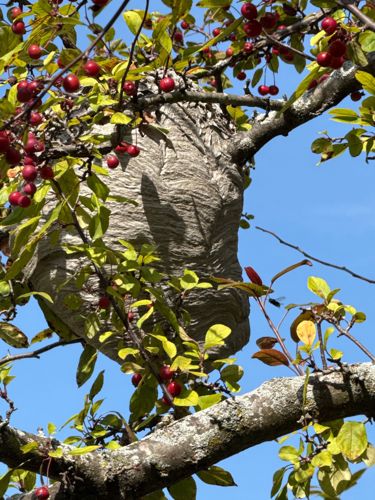Bald-faced Hornet (or Aerial Yellowjacket) Nest
Scientific Name: Dolichovespula maculata
Order & Family: Hymenoptera, Vespidae
Size: Workers are typically 1/2 to 5/8 inch (12 to 15 mm); Queens are larger, up to 3/4 inch (19 mm). The nest itself can be very large, spherical or pear-shaped, often 1-2 feet (30-60 cm) across.

Natural Habitat
Nests are typically built in trees (as seen in the image), large shrubs, or sometimes on structures like buildings. They prefer open areas in forests, suburban landscapes, and gardens.
Diet & Feeding
Adult bald-faced hornets feed on nectar, fruit juices, and other sugary liquids. They also forage for insects (other wasps, flies, caterpillars, spiders) to feed to their larvae.
Behavior Patterns
Bald-faced hornets are social insects that live in colonies. They construct distinctive paper nests made from chewed wood fibers mixed with saliva. Their colonies are annual, starting with a queen in spring and dying off in late fall, except for new queens. They are highly defensive of their nests and will sting repeatedly if threatened.
Risks & Benefits
Potential risks: They are highly aggressive when their nest is disturbed and can inflict painful stings. Individuals allergic to wasp stings face a severe health risk (anaphylaxis). Potential benefits: They are effective predators of other insect pests, contributing to pest control in gardens and agricultural settings.
Identified on: 9/22/2025